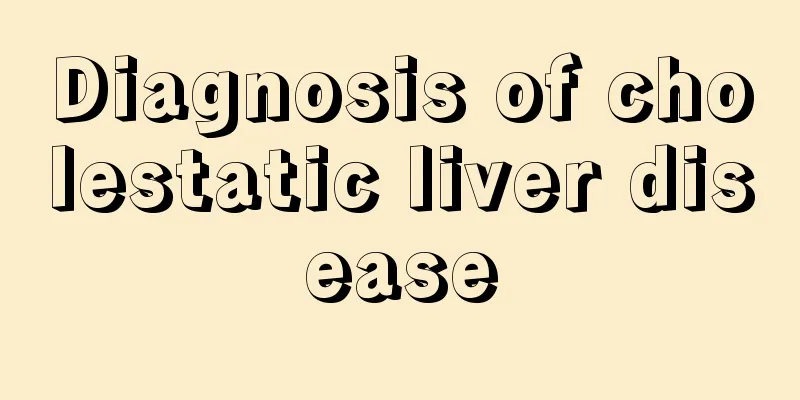Diagnosis of cholestatic liver disease

|
Cholestatic liver disease is a disease that affects a wide range of people, and both the elderly and the young may suffer from this disease. Patients with cholestatic liver disease will have obvious damage to their liver function and their detoxification function will be greatly reduced. Most patients will also have other organ diseases such as stomach problems, which are extremely harmful to the human body. So, how is cholestatic liver disease diagnosed? Causes The main causes include genetics, immunity, degeneration, infection, stones and tumors. This disease can affect any part of the entire biliary system from the bile duct formed by two adjacent hepatocytes to the duodenal ampulla, and can be divided into intrahepatic cholestasis and extrahepatic cholestasis. Common causes of intrahepatic cholestasis include viral hepatitis, drug-induced liver disease, primary biliary cirrhosis, and primary sclerosing cholangitis. Extrahepatic cholestasis is caused by mechanical obstruction of the bile duct. Common causes include common bile duct stones, gallbladder cancer, cholangiocarcinoma, etc. Clinical manifestations 1. Symptoms Symptoms include fatigue, loss of appetite, itchy skin, dark yellow urine like strong tea, lighter stool color, etc. People with long-term cholestasis may have symptoms of fat and fat-soluble vitamin absorption disorders, such as foul-smelling stools, steatorrhea, night blindness, osteoporosis, fractures, bone pain, testicular atrophy, and bleeding tendency. 2. Physical signs Jaundice is the most prominent physical sign of the patient, manifested as yellowing of the sclera and skin. Most patients have jaundice, but a few patients or those in the early stages of the disease may not develop jaundice. Skin pigmentation, ecchymoses, petechiae, and enlargement of the liver, spleen, and superficial lymph nodes throughout the body may also occur. examine 1. Laboratory examination (1) Elevated serum bilirubin, mainly conjugated bilirubin, negative urobilinogen and positive urine bilirubin. (2) Alkaline phosphatase may increase before bilirubin increases, and is generally less than 2.5 times the upper limit of normal. In cholestatic liver disease, alkaline phosphatase increases significantly. (3) Immunological examinations, such as anti-mitochondrial antibodies and anti-nuclear antibodies, are helpful in diagnosing autoimmune liver disease. (4) Serological examination and hepatitis virus markers are crucial for the etiological diagnosis of cholestasis. 2. Imaging examination (1) Abdominal ultrasound examination: It helps to differentiate intrahepatic or extrahepatic cholestasis and is the preferred method for detecting or excluding intrahepatic and extrahepatic bile duct dilatation and space-occupying lesions. (2) Magnetic resonance cholangiopancreatography: It can be used to show diseases of the biliary system and is a non-invasive method. (3) Endoscopic retrograde pancreaticocholangiopancreatography: It can also be used to display diseases of the biliary system. While imaging, specimens can be taken for cytological and histological examinations. It can also complete treatments such as biliary drainage, dilation, and stent placement. 3. Histopathological examination Liver tissue pathological examination is an effective method for diagnosing autoimmune liver disease, metabolic and hereditary liver disease, tumor and granulomatous diseases, and it helps to clarify the diagnosis of intrahepatic cholestasis of unknown cause. diagnosis 1. Clinical manifestations Jaundice persists for more than 3 weeks with no signs of disappearing, and may even progressively increase. It is accompanied by skin itching, loss of appetite, dark yellow urine like strong tea, and varying degrees of fatigue and gastrointestinal symptoms. 2. Auxiliary examination The diagnosis is made based on the results of laboratory tests, imaging tests, and other examinations. treat 1. Treatment of the primary disease is the key. 2. Endoscopy, radiological intervention and surgery are effective methods for treating extrahepatic cholestatic diseases. Treatment of intrahepatic cholestatic disease varies depending on the cause. In addition, related complications need to be actively treated. 3. Cholestasis can lead to vitamin absorption disorders and cause vitamin A, vitamin D, vitamin E, and vitamin K deficiencies, and should be treated with corresponding vitamins. 4. Chronic cholestatic liver disease and hormones can cause or aggravate osteoporosis. Calcium and vitamin D can prevent decalcification. |
<<: What are the benefits of black wolfberry tea
>>: What medicine is good for cholestasis
Recommend
What to do if your hair turns grey due to staying up late
If you stay up late too much, your body will easi...
Can people with advanced lung cancer eat onions, ginger and garlic?
In more serious cases, it is not conducive to the...
Steps to burn the tooth nerve
Toothache is not a serious disease, but many peop...
What to do about retinal arteriosclerosis? Common treatments include these
Retinal arteriosclerosis is a common disease amon...
Does hemisection of thyroid cancer still require low iodine?
If a thyroid cancer patient undergoes hemisection...
What causes butt pain?
In our daily life, we often feel pain in the butt...
How long does it take to get pregnant after colon cancer treatment
Colon cancer is a common malignant tumor of the d...
What foods are good for lowering blood pressure?
High blood pressure is a major problem that troub...
My teeth hurt at night but not during the day. What is the reason and how to treat it?
Has anyone ever experienced toothache at night bu...
What eye drops are good for high intraocular pressure
High intraocular pressure is extremely harmful to...
Is esophageal cancer hereditary?
Patients with esophageal cancer often worry about...
What causes meningitis?
There are many causes of meningitis. It may be ca...
How do patients with fibroids choose suitable exercise methods
How do patients with fibroids choose suitable exe...
Will nasopharyngeal carcinoma biopsy lead to metastasis?
Will a nasopharyngeal carcinoma biopsy lead to me...
Indications for bladder pacemaker
There is an old Chinese saying that a living pers...









